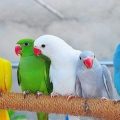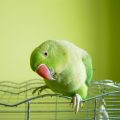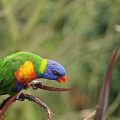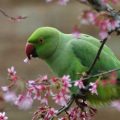Table of Contents
Ringneck parakeets, or specifically Indian Ringneck parakeets, have been human companions for nearly a century already. This is because of how their lovely physical attributes’ as well as their great personality really get people’ and influences thousands, more millions all around the world. They have been a popular bird on the internet, with owners really shouting their pride.
These birds are intelligent and, really, good-looking. They are the kinds of birds you could get lost in. They are affectionate and very friendly, easy to bond with owners and captivate friends and strangers; smart, witty, loyal, and the catch is, they are fairly low maintenance. Of course; if you are already in the dilemma of whether you should or should not get one of these; it is fair and smart to get to know them better. Let’s finally get to know Indian Ringneck Parakeets.
Indian Ringneck Parakeets openly resist their difficult reputation
As these birds have been human companions for almost a decade; they have grown to be merely an ornamental piece to every home. They have built a reputation of being nippy, as well as difficult to tame. Impressively enough, they continuously defy this reputation as they have found to make loving pets, if they are hand-fed as babies, properly socialized; and rightfully loved and cared for.
When they are gently handled by their caretakers, they generate really charming personalities. They adore working on new bird tricks, for instance waving hello with afoot. They love mental challenges; such as handling puzzles, and they love to mimic sounds of their owners; as well as silly mundane sounds of their surroundings.
Ringnecks might cause some stress and troubles undergoing their adolescence
While they do not overall deserve their bad reputation, they can really be a handful in their stage of adolescence. Like other bird species, young ringnecks; the ones specifically on their 4 months to 1-year-olds, often undergo what we called a “bluffing” phase.
In the phase, an increase in hormonal changes appears and it heightens the bird’s aggressive tendencies. Here, you might be stressed because there are instances where they hiss, bite, and resist most interactions. Some inexperienced caregivers might also commit the mistake of avoiding interaction with their very own; but it will just make their bird even more stressed and antisocial. With this, the key is to try to bond using good encouraging behaviors. It is also to be noted that the phase will only be for a few months.
Ringnecks are called either parakeets or parrots
Generally, they identify as parakeets, but these Indian ringnecks are also parrots. These birds have been referred to as parakeets, because of their size, their medium; and their long feathers, both of which are trademark features of all parakeets. Notwithstanding, many people refer to them as Indian ringneck parrots, which also holds accuracy. Despite their medium size, their long tails cause them the need for a larger cage than one might assume.
Ringnecks have a variety of colors
Indian ringnecks parakeets are normally bright green with some blue tail feathers and yellow under their wings. Their male types, often added, sport black and rose rings around their neck, as well as black facial stamps.
Selective breeding programs have paved the way to raise a number of beautiful color mutations within the species. This had led to ringnecks having hues of blue; yellow as well as white, pink, purple, a fascinating and striking color combination.
They are excellent talkers
While it is never a sure thing that a bird is guaranteed to learn to talk; opting for ringneck will increase up the probability. These birds are infamous talkers. In fact, they were once considered sacred in their native environment based on their astonishing ability to imitate human speech.
Their speech holds impeccable clarity, alongside their wonderful ability to learn, doze, even hundreds of worlds unfailingly surprise people. Their voice is one of the most charming and enticing sounds to hear, that stands out among other companion birds. They start talking between 8 months and 1-year-old and have the wits; especially if their caretaker spends a lot of quality time communicating with them every day.
They never give up
If your bird is acting tenacious, it is not in your imagination. Ringnecks are known for their resiliency and being resourceful. They are one of the few types of parakeet species on our cloud to successfully adapt; and thrive amidst facing disturbing natural habitats.
They do not stand small in changing weather conditions, and this is to be practiced in captivity as well. Furthermore, they learned the hard way how to take care of themselves; and develop courage when faced with difficulty and uneasiness. For instance, they have grown to be social to survive human connections. They make an effort to form serious connections partly because of their eagerness to thrive and prosper; and partly because it’s innate in them to be affectionate and lovable.
Conclusion
It is always a great thing to have unraveled knowledge about birds, and this time, with Indian ringneck parakeets, it is definitely a great experience. Getting to know these endearing birds better, I hope, has equipped you to decide yes to getting one of them. Getting one for yourself is worth every bit, as their resilient, friendly and affectionate personality together with pleasing in the eyes look will definitely speak to your existence and eagerness to care for it.





 Author and long-time animal lover. Sharing knowledge on pet care through experience and the written word.
Author and long-time animal lover. Sharing knowledge on pet care through experience and the written word.